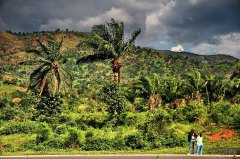The planting technology of coffee tree introduces the environment in which coffee tree is suitable to grow.
Field management of loosening soil and weeding: when the seedling height is 3cm to 6cm, the weak or overdense seedlings are pulled out; when the seedling height is 10cm and 13cm, the plant distance is about 30cm. Soil loosening and weeding were carried out at the same time between seedlings and fixed seedlings to keep the soil loose. Coffee beans are relatively drought-tolerant, and the soil can grow normally under general moisture. During drought, proper watering is appropriate, but less watering should be given to squatting seedlings during the seedling setting period. When White Dew (early September), the fruit tends to mature and can be stopped watering. Topdressing: the seedling height is about 35 cm, before the plant is closed, the seedlings are applied 20 kg of superphosphate and 10 kg of ammonia sulfate, mixed between the rows, and then ploughed to cultivate the soil, the fertilizer is buried in the soil, and can prevent the plant from lodging. Fourth, the most common disease of coffee bean is gray leaf spot, which is caused by a kind of half-known fungus in fungi, which mainly harms the leaves. At the beginning, a light brown spot appeared in the middle of the leaf, and then a gray mildew was produced on the spot. Before or at the initial stage of the disease, 65% Dysen zinc solution 500 times or 800 times 1000 times was sprayed to remove and treat. Insect pests mostly occurred in late spring and early summer, mainly aphids, sprayed with dimethoate emulsion into 200 times solution. Fifth, harvest, processing and storage of coffee beans gradually mature when the Autumn Equinox (late September), and begin to harvest when the pods turn red. Coffee beans should be stored in a ventilated, dry and cool place, pay attention to moistureproof and prevent rodent damage, select more than 85% of the buds as seeds. Soil preparation: in the selected plots, 2000-2500 kg of ring fertilizer and 25 kg of superphosphate are applied per mu, which are evenly scattered on the ground, ploughed and raked fine and leveled, and generally do not make beds. If a bed is made, it can be made into a flat bed 1.2 to 1.5 meters wide. Sowing: soak the superior seeds selected by the test in 50 ℃ warm water for one day and night, wait for them to absorb water to expand, fish out the dry surface, and sow seeds. The sowing time is from Qingming Festival to Grain Rain (mid-April), when the air temperature is 15-20 ℃, it is too early, the ground temperature is low, the seeds are easy to rot in the soil, and too late, the seeds can not mature, affecting the yield and quality. Sowing with strip sowing is appropriate, row spacing 50-70 cm, open 5-6 cm deep ditch, spread seeds evenly in the ditch, cover soil 3 cm, slightly suppress, and emerge about 10 days after sowing. If there is a drought in the north, it is necessary to irrigate before sowing, and not to water after sowing, so as not to affect the emergence of coffee planting techniques. First, the growth habits of coffee like warmth, drought tolerance, cold tolerance, fear of frost damage, seedlings and adult plants are easily defoliated to death by frost, seeds can not mature. Coffee is not strict on the land, idle land can also be planted, but with good drainage, deep soil, loose and fertile sandy soil is appropriate. Second, seed selection of planting techniques: before sowing, the germination rate of seeds should be tested. Specific method: divide the full seeds into several parts, number them in turn, take out 125 to 250 grams in each part and put them into corresponding numbered utensils, soak them in warm water for about 50 ℃ for one day and night, pour out the water, rinse it again with clean water, then cover it with a wet cloth to maintain humidity, and sprout after three days.

Important Notice :
前街咖啡 FrontStreet Coffee has moved to new addredd:
FrontStreet Coffee Address: 315,Donghua East Road,GuangZhou
Tel:020 38364473
- Prev

Ethiopia Sidamo Sidamo Guji Shakiso coffee bean agent
The coffee flavor of Sidamo is very diverse, because of the different soil composition, regional microclimate and countless native coffee varieties, the coffee produced in each urban area has obvious differences and characteristics. Sidamo producing area (Sidama) is located in the south of Ethiopia. The industry here is mainly agricultural, and the coffee growing area is located around the Great Rift Valley (Great Rift Valley) of East Africa.
- Next

Sunburn Yega Chevy Ethiopia Erega arichaG1 Grade Yega Fine Coffee
About the winner of the Project Origin Sasa Sestic,2015 World Barista Competition, he and his business team ONA Coffee started a raw bean shopping project called Project Origin three years ago. The project works directly with coffee growers in poor countries and regions to improve their production conditions and give them a purchase price 20% higher than the fair trade price.
Related
- Does Rose Summer choose Blue, Green or Red? Detailed explanation of Rose Summer Coffee plots and Classification in Panamanian Jade Manor
- What is the difference between the origin, producing area, processing plant, cooperative and manor of coffee beans?
- How fine does the espresso powder fit? how to grind the espresso?
- Sca coffee roasting degree color card coffee roasting degree 8 roasting color values what do you mean?
- The practice of lattes: how to make lattes at home
- Introduction to Indonesian Fine Coffee beans-- Java Coffee producing area of Indonesian Arabica Coffee
- How much will the flavor of light and medium roasted rose summer be expressed? What baking level is rose summer suitable for?
- Introduction to the characteristics of washing, sun-drying or wet-planing coffee commonly used in Mantenin, Indonesia
- Price characteristics of Arabica Coffee Bean Starbucks introduction to Manning Coffee Bean Taste producing area Variety Manor
- What is the authentic Yega flavor? What are the flavor characteristics of the really excellent Yejasuffi coffee beans?

